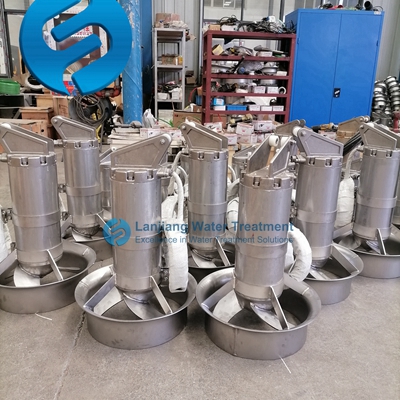Sewage mixer plays a crucial role in the sewage treatment process, and its role is mainly reflected in the following aspects:

First, promote material mixing and suspension
Mixing evenly: The sewage mixer fully mixes the solid matter and liquid in the sewage through the mixing effect to ensure the uniform distribution of substances in the treatment process. This provides good basic conditions for subsequent treatment processes, such as precipitation, filtration, oxidation, etc.
Suspended solids: Solid substances in sewage are easy to deposit at the bottom, resulting in turbidity of the water. By stirring, the mixer suspends the solid material into the water body, making it easier to be captured and treated by the subsequent treatment process. This effect helps to improve treatment efficiency and effluent quality.
Second, enhance the contact between microorganisms and organic matter
Promote microbial decomposition: In activated sludge treatment, sewage mixers help maintain the mixing of sludge and sewage, ensuring that microorganisms can effectively decompose pollutants. By stirring, microorganisms are able to more fully contact the organic matter in the sewage, thereby increasing the rate and efficiency of biodegradation.
Maintain the mixed state: The operation of the mixer can maintain the mixed state of the activated sludge method, avoid uneven sludge settlement, and ensure the stability and reliability of the treatment effect.
Third, prevent sludge deposition and pipeline blockage
Prevent sludge deposition: In a water body that is still for a long time, sludge is easy to deposit at the bottom to form sediment. The use of mixers can prevent the occurrence of this phenomenon, maintain the fluidity of the sludge, and avoid the formation of dead corners and silting areas.
Keep pipes clear: Solid materials in sewage are prone to deposit in pipes, causing blockage. The mixer prevents solid substances from being deposited in the pipeline through the stirring action, keeps the pipeline unimpeded, and improves the processing efficiency.
Fourth, promote chemical reactions
In some chemical processing steps, the role of the blender can not be ignored. By stirring, chemicals can be more evenly mixed into the sewage, in full contact with pollutants and react. This helps to improve the effectiveness and efficiency of chemical treatment.
Fifth, uniform heating or cooling
The mixer also helps to transfer heat evenly in cases where the temperature of the sewage needs to be adjusted. By stirring, the heat can be more evenly distributed throughout the water body, thus achieving a uniform heating or cooling effect.
Sixth, other functions
Increased processing efficiency: The use of mixers can speed up the rate of biodegradation and chemical reactions, thereby improving the overall processing efficiency.
Energy saving and consumption reduction: Modern sewage mixer design optimization, can achieve efficient mixing with low energy consumption, reduce operating costs.
Reduced maintenance: The durable mixer design reduces failure rates and reduces maintenance costs.
Strong adaptability: Different types of mixers can be selected according to specific sewage treatment needs to meet various working conditions.
Easy to operate: many sewage mixers are equipped with automatic control systems, which simplifies the operation process and reduces the work burden of operators.
To sum up, the sewage mixer has many functions in the sewage treatment process, which is of great significance for improving the treatment efficiency, effluent quality and reducing operating costs.
Nanjing LanJiang Water Treatment Equipment Co.,Ltd manufactures equipment for wastewater treatment. We were established in 2001. Since then, we designed and produced submersible mixers, top entry mixers, aerators and other wastewater treatment equipment.
Post time:2024-09-23